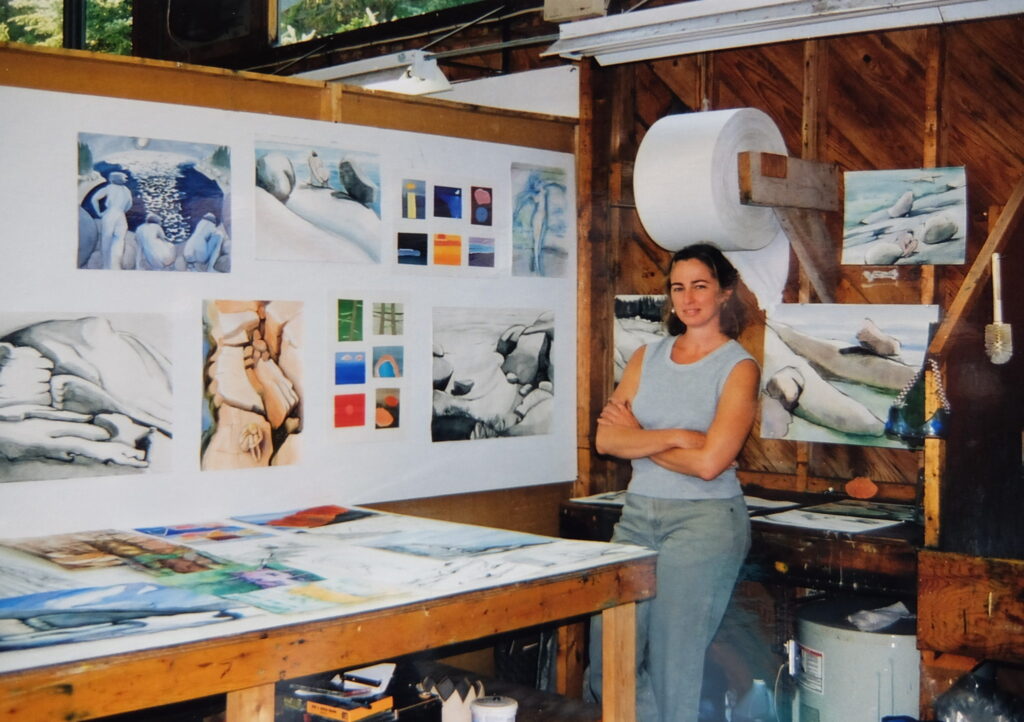The Immortal Life of Holly Meade
Jenny Smick was traveling in Mexico when her mom’s ovarian cancer recurred. Smick was 30 years old and had only a few obligations to consider before flying home to be with her: a handful of material possessions, an already temporary job teaching English, and an uncertain relationship.
Six months after Smick landed in Boston and traveled north to Sedgwick, Maine, her mother, Holly Meade, passed away. The next day, as usual, Smick flipped over the open sign at her mom’s art gallery in the tiny coastal town.
“I didn’t know what else to do. People stopped in. They connected with her through art. They loved her,” Smick said.
Meade raised Smick and her brother as a single mom on the coast of Massachusetts. Every summer Meade would haul her kids north to Maine, plunk them into a rundown Boston Whaler that only ran backwards, and ferry them across the bay to a small island off the coast of Harpswell. There they would spend a month or two roughing it, completely off the grid but in their favorite place on earth.
Smick recalls that she never realized the oddity of what was her life. The entire living room in her family’s Massachusetts home had been her mother’s studio, covered from floor to ceiling in different phases of whatever project Meade was working on. A 1978 graduate of Rhode Island School of Design, in 1992 Meade had landed her first job illustrating a children’s book. She went on to illustrate more than 30 books, including Hush! A Thai Lullaby by Minfong Ho, which brought her a Caldecott Honor for her artwork. It wasn’t until 2002 that Meade began making woodblock prints, the medium for which she is most known. After taking a class from Hester Stinnett at Haystack Mountain School, Meade began devoting nearly all of her time to the art form.
In 2003 Meade sold their home to begin a full-time life in Sedgwick and invest in two major purchases: a large-format, original print by Deer Isle printer Siri Beckman and a Whelan press—a major upgrade from pressing prints with the back of a spoon. For the next ten years Meade made art on the coast of Maine, drawing inspiration from her wild surroundings. When she got sick, neighbors came out of the woodwork to help however they could, from running her gallery to purchasing her home and letting her rent it so she could afford to stay in her spot by the sea.
In the months following her mom’s death, Smick took on a new and interesting role: the deceased artist’s daughter. And not just the daughter of any artist, but the daughter of Holly Meade—local sweetheart who just happened to create some of the most thought-provoking and beautiful woodblock prints of her time. Smick continued to run her mother’s gallery for several months after she passed away, offering a literal shoulder for people to cry on, while also processing her own grief over losing a parent at such a young age. Eventually, the situation became more bearable. She continued to work at galleries, narrowing her focus to her mother’s art, which sat in a pair of thousand-pound flat files in her home. She spoke about her mother’s art career at events, in newsletters, and even on webinars, reminiscing with complete strangers about the pure talent that Holly Meade possessed.
“Some people can’t talk about their parent who died; they can barely get through a sentence,” says Smick. “I can talk at length about Holly Meade because I’ve had to. And I love talking about her. She was awesome. But I wonder if I’m getting it right; I wonder if I’m saying something she believes, and I don’t know.”
Smick says her mom was in denial about death for most of the two-plus years that she was sick. It wasn’t until the final weeks that Meade got things in order. That’s when she told Smick she could burn all her artwork if it ever became too much.
“This is what’s happening when you have an artist parent. It makes me feel so good to share her work with people, but it’s also this huge physical and emotional burden that my mom never wanted me to have,” she says. “Obviously I don’t want to burn her work, but I’ve thought about it. It’s a little escape door that’s there that I don’t want to take, but it lets me feel like whatever I do is okay. I don’t have the pressure, and that’s what she would have wanted.”
Since becoming a mother herself six years ago, Smick says, she has even more respect for all that Holly Meade accomplished, and despite closing her mother’s gallery years ago, she still has strangers emailing her, looking for connection over her mother’s art. She continues to sell the prints, primarily through Courthouse Gallery Fine Art in Ellsworth. Smick also started an Etsy page and began selling Meade’s work in greeting card form, a format that she says she loves for its simplicity and accessibility.
In 2017 Smick compiled a book about her mother, Holly Meade Wood Block and Linoleum Prints (She-Bear Gallery, 2017), with reflections and images of nearly all of Meade’s work. The book sold out long ago, but Smick is considering a reprint in the next few years. She can glance at any one of her mother’s pieces and rattle off a detailed description of its history: when her mother created it, where she was living at the time, possible influences that may have been in effect. And a huge influence that runs strong throughout most of Meade’s prints is the quiet coast of Maine—the place that helped her raise her children, helped her find her career, and helped her ease into the idea of death.
“I’m never alone in missing her,” Smick says.
